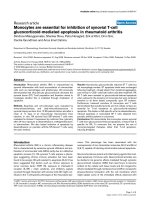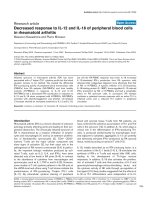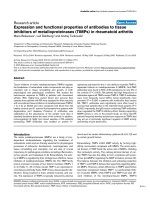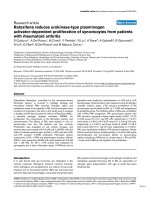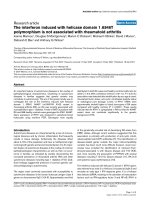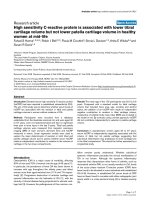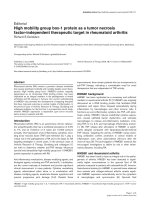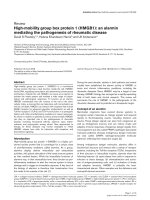Báo cáo y học: "High mobility group box-1 protein as a tumor necrosis factor-independent therapeutic target in rheumatoid arthritis." ppsx
Bạn đang xem bản rút gọn của tài liệu. Xem và tải ngay bản đầy đủ của tài liệu tại đây (42.05 KB, 2 trang )
Page 1 of 2
(page number not for citation purposes)
Available online />Abstract
Rheumatoid arthritis (RA) remains a prevalent disease worldwide
that causes significant morbidity and mortality despite recent thera-
peutics. High mobility group box-1 (HMGB1) protein, originally
appreciated as an intranuclear DNA binding protein, has been
implicated as an integral mediator in the pathogenesis of animal
arthritides and RA disease in humans. Our current understanding
of HMGB1 has promoted the development of targeting therapies
that have improved outcomes in animal models of inflammation. In
the previous issue of Arthritis Research & Therapy, Sundberg and
colleagues address, for the first time in a prospective cohort study,
whether HMGB1 expression is dependent upon tumor necrosis
factor activity in patients with RA.
Introduction
Rheumatoid arthritis (RA) is an autoimmune chronic destruc-
tive polyarthropathy that has a worldwide prevalence of 0.5%
to 1%, and an incidence of 3 cases per 10,000 persons
annually. Over-expression of pro-inflammatory cytokines, inclu-
ding tumor necrosis factor (TNF) and interleukin (IL)-1, play a
critical role in the pathogenesis of RA and is the basis for RA
targeting strategies in recent years. In the previous issue of
Arthritis Research & Therapy, Sundberg and colleagues [1]
set forth to determine whether anti-TNF therapy influences
synovial and extracellular high mobility group box-1 (HMGB1)
protein expression in patients with RA.
Anti-inflammatory medications, disease modifying agents, and
biological agents, including anti-TNF and anti-IL-1 antibodies,
are the current mainstay of treatment and provide significant
clinical improvement in many patients. Cytokine neutralizing
agents, administered either alone or in combination with
disease modifying agents, ameliorate disease symptoms and
prevent progressive joint damage [2-4]. Despite these
improvements, there remain patients who are unresponsive to
anti-TNF therapy, indicating a considerable need for novel
therapeutics that are independent of TNF activity.
HMGB1 background
HMGB1 has been implicated as a necessary and sufficient
mediator in experimental arthritis [5-7]. HMGB1 was originally
discovered as a DNA binding protein that facilitates DNA
replication and repair. Once released extracellularly during
inflammation by macrophages and other immune cells, it
functions as a pro-inflammatory cytokine, like TNF, with pleio-
tropic activity. HMGB1 induces endothelial cytokine expres-
sion, causes epithelial barrier dysfunction, and activates
macrophages to release pro-inflammatory mediators, inclu-
ding TNF, IL-1α, IL-6, and macrophage inflammatory protein-
1α [8]. TNF release after stimulation of HMGB1 is signifi-
cantly delayed compared with lipopolysaccharide-induced
TNF release. Targeting the activity of HMGB1 using neutra-
lizing antibodies confers protection in animal models of
inflammation even when administered 24 hours after the
onset of injury [9]. The promulgation of HMGB1 research has
encouraged investigators to define its role in other inflam-
matory diseases, including RA.
HMGB1 and rheumatoid arthritis
HMGB1 has been found to have an integral role in the patho-
genesis of arthritis. HMGB1 has been detected in signifi-
cantly higher concentrations in the synovial fluid of RA
patients compared to patients with osteoarthritis [5]. Immuno-
histochemical staining for HMGB1 in synovial tissue obtained
from animals with collagen-induced arthritis reveals signifi-
cant HMGB1 expression extracellularly and in the cytoplasm
of macrophages and synoviocytes [6]. Synovial fluid
Editorial
High mobility group box-1 protein as a tumor necrosis
factor-independent therapeutic target in rheumatoid arthritis
Richard S Goldstein
Department of Emergency Medicine and The Feinstein Institute for Medical Research, North Shore University Hospital, Community Drive, Manhasset,
NY 11030, USA
Corresponding author: Richard S Goldstein,
Published: 2 June 2008 Arthritis Research & Therapy 2008, 10:111 (doi:10.1186/ar2427)
This article is online at />© 2008 BioMed Central Ltd
See related research article by Sundberg et al., />HMGB1 = high mobility group box-1; IL = interleukin; RA = rheumatoid arthritis; rHMGB1 = recombinant high mobility group box-1; TNF = tumor
necrosis factor.
Page 2 of 2
(page number not for citation purposes)
Arthritis Research & Therapy Vol 10 No 3 Goldstein
macrophages express receptor for advanced glycation end
products, and release TNF, IL-1β, and IL-6 upon stimulation
with HMGB1 [5]. Intra-articular injection of recombinant
HMGB1 (rHMGB1) induces arthritis in animals and shares
key histological features observed in RA, including pannus
formation, synovial membrane hypertrophy, and mononuclear
cell predominance within synovial tissue [7]. The injection of
rHMGB1 results in mild to moderate synovitis and may
persist for at least 28 days. The induction of arthritis by
rHMGB1 is primarily mediated by IL-1 as confirmed by the
absence of arthritis in IL-1 receptor-deficient mice after
rHMGB1 administration [7]. Systemic administration of either
neutralizing HMGB1 antigen-affinity purified polyclonal anti-
bodies or the anti-inflammatory domain of HMGB1, termed
the A-box protein, significantly reduced mean arthritis scores,
disease-induced weight loss, and the histological severity of
arthritis in an animal model of collagen-induced arthritis [6].
The presence of HMGB1 in arthritis models, the recapitula-
tion of arthritis upon rHMGB1 administration, and the improve-
ment of disease after HMGB1 inhibition implicate HMGB1 as
a key mediator and potential therapeutic target in RA.
HMGB1 as a novel therapeutic
The recent article from Sundberg and colleagues [1] studies
the relationship between systemic TNF blockade and synovial
expression of HMGB1. Arthroscopy samples were obtained
1 to 21 days before and 8 to 10 weeks after initiation of anti-
TNF monoclonal antibody (infliximab) treatment. Cytoplasmic
and extracellular expression of HMGB1 decreased in five
patients, remained unchanged in one, and increased in three,
rendering the authors’ results statistically insignificant. HMGB1
mRNA expression remained unchanged after infliximab therapy
as indicated by only two of the six patients studied by RT-
PCR having decreased HMGB1 mRNA levels. In addition, no
correlation was observed between clinical response and the
direction of change of HMGB1 expression. The authors
concluded that their results reveal an unaffected expression
of HMGB1 in synovia from patients with RA before and
during TNF blockade with infliximab [1].
In corroboration with the authors’ findings, a recent study by
my colleagues and I revealed elevated serum levels of
HMGB1 in RA patients, seven (>50%) of whom were recei-
ving anti-TNF therapy [10]. Recent experimental evidence has
revealed that in addition to TNF, both IL-1 and interferon-γ
induce HMGB1 release from activated macrophages. These
data support the possibility that redundant mechanisms may
contribute to HMGB1 signaling and that its activity might be
independent of TNF during chronic inflammation.
Despite notable findings from the current study by Sundberg
and colleagues, however, inherent limitations of the experi-
mental design exist. First, it is difficult to derive powerful
correlations given the relatively small patient cohort.
Secondly, approximately 30% of patients had disease duration
greater than or equal to 10 years. Furthermore, the study was
confined to specimens from a single joint and sampling of
joint tissue may be problematic given regional variation.
Therefore, additional studies are required to further establish
the relationship of HMGB1 and TNF in patients with RA.
The present study supports the hypothesis that HMGB1
release is independent of TNF activity in patients with RA. If
reproduced in larger clinical trials then, together with the
growing body of preclinical work, the development of anti-
HMGB1 antibodies as an experimental therapeutic for future
study is warranted.
Competing interests
The author declares that they have no competing interests.
References
1. Sundberg E, Grundtman C, Klint E, Lindberg J, Ernestam S,
Ulfgren K, Harris H, Andersson U: Systemic TNF blockade does
not modulate synovial expression of the proinflammatory
mediator HMGB1 in rheumatoid arthritis patients - a prospec-
tive clinical study. Arthritis Res Ther 2008, 10:R33.
2. Maini R, St Clair EW, Breedveld F, Furst D, Kalden J, Weisman M,
Smolen J, Emery P, Harriman G, Feldmann M, Lipsky P: Infliximab
(chimeric anti-tumour necrosis factor
αα
monoclonal antibody)
versus placebo in rheumatoid arthritis patients receiving con-
comitant Methotrexate: a randomized phase III trial. Lancet
1999, 354:1932-1939.
3. Lipsky PE, van der Heijde DM, St Clair EW, Furst DE, Breedveld
FC, Kalden JR, Smolen JS, Weisman M, Emery P, Feldmann M,
Harriman GR, Maini RN; Anti-Tumor Necrosis Factor Trial in
Rheumatoid Arthritis with Concomitant Therapy Study Group:
Infliximab and methotrexate in the treatment of rheumatoid
arthritis. New Engl J Med 2000, 343:1594-1602.
4. Weinblatt ME, Kremer JM, Bankhurst AD, Bulpitt KJ, Fleischmann
RM, Fox RI, Jackson CG, Lange M, Burge DJ: A trial of etaner-
cept, a recombinant tumor necrosis factor receptor:Fc fusion
protein, in patients with rheumatoid arthritis receiving
Methotrexate. New Eng J Med 1999, 340:253-259.
5. Taniguchi N, Kawahara K, Yone K, Hashiguchi T, Yamakuchi M,
Goto M, Inoue K, Yamada S, Ijiri K, Matsunaga S, Nakajima T,
Komiya S, Maruyama I: High mobility group box chromosomal
protein 1 plays a role in the pathogenesis of rheumatoid
arthritis as a novel cytokine. Arthritis Rheum 2003, 48:971-981.
6. Kokkola R, Li J, Sundberg E, Aveberger AC, Palmblad K, Yang H,
Tracey KJ, Andersson U, Harris HE: Successful treatment of
collagen-induced arthritis in mice and rats by targeting extra-
cellular high mobility group box chromosomal protein 1 activ-
ity. Arthritis Rheum 2003, 48:2052-2058.
7. Pullerits R, Jonsson IM, Verdrengh M, Bokarewa M, Andersson U,
Erlandsson-Harris H, Tarkowski A: High mobility group box
chromosomal protein 1, a DNA binding cytokine, induces
arthritis. Arthritis Rheum 2003, 48:1693-1700.
8. Andersson U, Wang H, Palmblad K, Aveberger AC, Bloom O,
Erlandsson-Harris H, Janson A, Kokkola R, Zhang M, Yang H,
Tracey KJ: High mobility group 1 protein (HMG-1) stimulates
proinflammatory cytokine synthesis in human monocytes. J
Exp Med 2000, 192:565-570.
9. Wang H, Bloom O, Zhang M, Vishnubhakat JM, Ombrellino M,
Che J, Frazier A, Yang H, Ivanova S, Borovikova L, Manogue KR,
Faist E, Abraham E, Andersson J, Andersson U, Molina PE,
Abumrad NN, Sama A, Tracey KJ: HMG-1 as a late mediator of
endotoxin lethality in mice. Science 1999, 285:248-251.
10. Goldstein RS, Bruchfeld A, Yang L, Qureshi AR, Gallowitsch-
Puerta M, Patel NB, Huston BJ, Chavan S, Rosas-Ballina M,
Gregersen PK, Czura CJ, Sloan RP, Sama AE, Tracey KJ: Cholin-
ergic anti-inflammatory pathway activity and high mobility
group box-1 (HMGB1) serum levels in patients with rheuma-
toid arthritis. Mol Med 2007, 13:210-215.
